Fig 4.7, 4.8#
Symmetric (bistable) biological networks.
using OrdinaryDiffEq
using ModelingToolkit
using Plots
Plots.default(linewidth=2)
Model
@independent_variables t
@variables A(t) B(t)
@parameters k1 k2 k3 k4 n1 n2
D = Differential(t)
eqs = [
D(A) ~ k1 / (1 + B^n1) - k3 * A,
D(B) ~ k2 / (1 + A^n2) - k4 * B,
]
@mtkbuild osys = ODESystem(eqs, t)
\[\begin{split} \begin{align}
\frac{\mathrm{d} A\left( t \right)}{\mathrm{d}t} &= \frac{\mathtt{k1}}{1 + \left( B\left( t \right) \right)^{\mathtt{n1}}} - \mathtt{k3} A\left( t \right) \\
\frac{\mathrm{d} B\left( t \right)}{\mathrm{d}t} &= \frac{\mathtt{k2}}{1 + \left( A\left( t \right) \right)^{\mathtt{n2}}} - \mathtt{k4} B\left( t \right)
\end{align}
\end{split}\]
Fig 4.7 A#
Asymmetric parameter set
ps1 = Dict(k1=>20, k2=>20, k3=>5, k4=>5, n1=>4, n2=>1)
tend = 4.0
prob47 = ODEProblem(osys, [3, 1], tend, ps1)
sol1 = solve(prob47)
sol2 = solve(remake(prob47, u0=[1, 3]))
ax1 = plot(sol1, xlabel="Time", ylabel="Concentration", legend=:right, title= "Fig 4.7A (1)")
ax2 = plot(sol2, xlabel="Time", ylabel="Concentration", legend=:right, title= "Fig 4.7A (2)")
plot(ax1, ax2, layout=(2, 1), size=(600, 600))
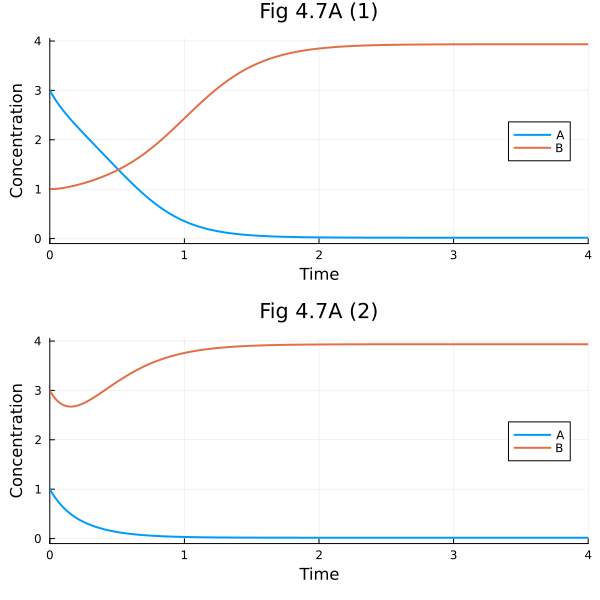
Fig 4.7 B#
∂F47 = function (x, y; scale=20)
da, db = prob47.f([x, y], prob47.p, nothing)
s = sqrt(hypot(da, db)) * scale
return (da / s, db / s)
end
#3 (generic function with 1 method)
Grid points
r = range(0, 5, 21)
xx = [x for y in r, x in r]
yy = [y for y in r, x in r];
fig = plot(title="Fig 4.7 B (Vector field with nullclines)")
quiver!(fig, xx, yy, quiver=∂F47, line=(:lightgrey), arrow=(:closed), aspect_ratio=:equal)
∂A47 = (x, y) -> prob47.f([x, y], prob47.p, nothing)[1]
∂B47 = (x, y) -> prob47.f([x, y], prob47.p, nothing)[2]
contour!(fig, 0:0.01:5, 0:0.01:5, ∂A47, levels=[0], cbar=false, line=(:black))
plot!(fig, Float64[], Float64[], line=(:black), label="A nullcline")
contour!(fig, 0:0.01:5, 0:0.01:5, ∂B47, levels=[0], cbar=false, line=(:black, :dash))
plot!(fig, Float64[], Float64[], line=(:black, :dash), label="B nullcline")
plot!(fig, xlim=(0, 5), ylim=(0, 5), legend=:topright, size=(600, 600), xlabel="[A]", ylabel="[B]")
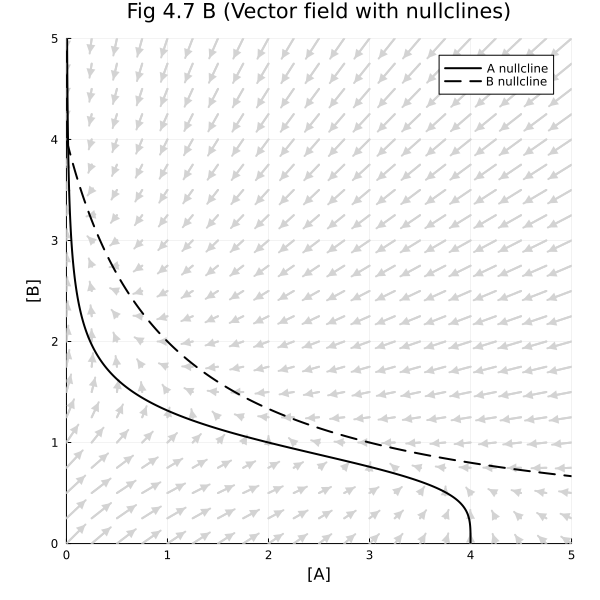
Fig 4.8#
Symmetric parameter set
ps2 = Dict(k1=>20, k2=>20, k3=>5, k4=>5, n1=>4, n2=>4)
tend = 4.0
prob48 = ODEProblem(osys, [3, 1], tend, ps2)
sol1 = solve(prob48)
sol2 = solve(remake(prob48, u0=[1, 3]))
ax1 = plot(sol1, xlabel="Time", ylabel="Concentration", legend=:right, title= "Fig 4.8A (1)")
ax2 = plot(sol2, xlabel="Time", ylabel="Concentration", legend=:right, title= "Fig 4.8A (2)")
plot(ax1, ax2, layout=(2, 1), size=(600, 600))
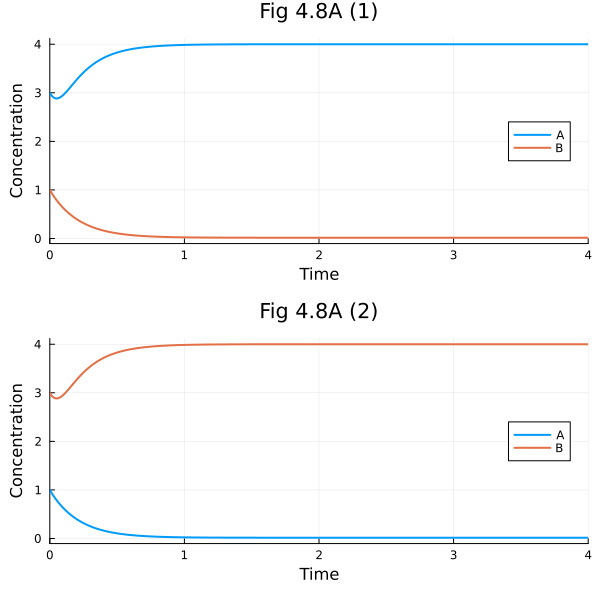
∂F48 = function (x, y; scale=20)
da, db = prob48.f([x, y], prob48.p, nothing)
s = sqrt(hypot(da, db)) * scale
return (da / s, db / s)
end
∂A48 = (x, y) -> prob48.f([x, y], prob48.p, nothing)[1]
∂B48 = (x, y) -> prob48.f([x, y], prob48.p, nothing)[2]
#25 (generic function with 1 method)
fig = plot(title="Fig 4.8 B")
quiver!(fig, xx, yy, quiver=∂F48, line=(:lightgrey), arrow=(:closed), aspect_ratio=:equal)
contour!(fig, 0:0.01:5, 0:0.01:5, ∂A48, levels=[0], cbar=false, line=(:black))
plot!(fig, Float64[], Float64[], line=(:black), label="A nullcline")
contour!(fig, 0:0.01:5, 0:0.01:5, ∂B48, levels=[0], cbar=false, line=(:black, :dash))
plot!(fig, Float64[], Float64[], line=(:black, :dash), label="B nullcline")
plot!(fig, xlim=(0, 5), ylim=(0, 5), legend=:topright, size=(600, 600), xlabel="[A]", ylabel="[B]")
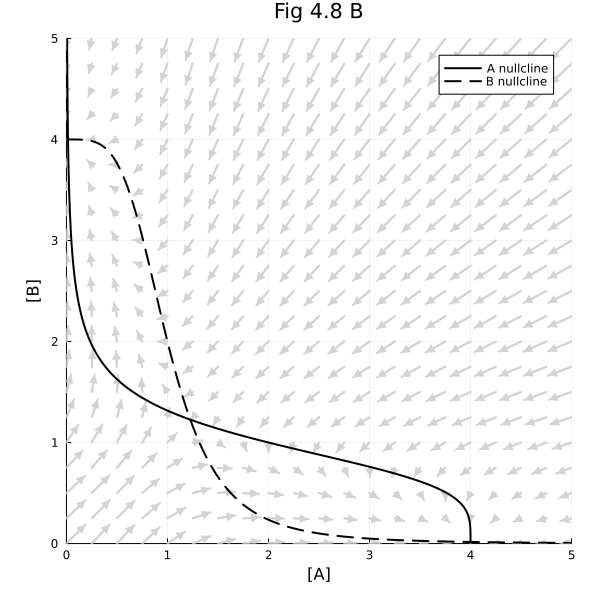
Fig 4.8 C#
around the unstable steady-state
r2 = range(1.0, 1.5, 16)
xx2 = [x for y in r2, x in r2]
yy2 = [y for y in r2, x in r2]
fig = plot(title="Fig 4.8 C (close up)")
quiver!(fig, xx2, yy2, quiver=(x, y)-> ∂F48(x, y; scale=60), line=(:lightgrey), arrow=(:closed), aspect_ratio=:equal)
contour!(fig, 1:0.01:1.5, 1:0.01:1.5, ∂A48, levels=[0], cbar=false, line=(:black))
plot!(fig, Float64[], Float64[], line=(:black), label="A nullcline")
contour!(fig, 1:0.01:1.5, 1:0.01:1.5, ∂B48, levels=[0], cbar=false, line=(:black, :dash))
plot!(fig, Float64[], Float64[], line=(:black, :dash), label="B nullcline")
plot!(fig, xlim=(1, 1.5), ylim=(1, 1.5), legend=:topright, size=(600, 600), xlabel="[A]", ylabel="[B]")
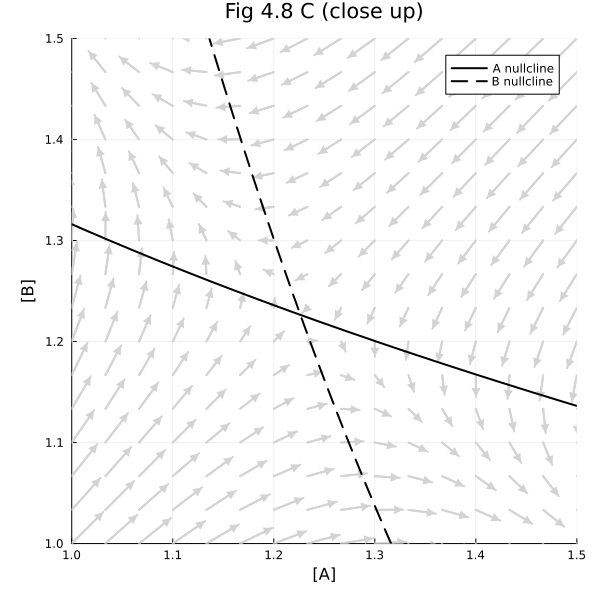
Another way to draw nullclines is to find the analytical solution when dA (or dB) is zero. And then sketch the nullclines in a parameteric plot.
nca47(b, p) = p.k1 / p.k3 / (1 + b^p.n1)
ncb47(a, p) = p.k2 / p.k4 / (1 + a^p.n2)
pls = map((8.0, 16.0, 20.0, 35.0)) do k1
ps = (k1=k1, k2=20., k3=5., k4=5., n1=4., n2=4.)
pl = plot(b -> nca47(b, ps), identity, 0., 7., label="Nullcline A")
plot!(pl, identity, a -> ncb47(a, ps), 0., 7., label="Nullcline B")
plot!(pl, title = "K1 = $k1", xlim=(0., 7.), ylim=(0., 7.), aspect_ratio = :equal, xlabel="[A]", ylabel="[B]")
pl
end
plot(pls..., size = (800, 800))
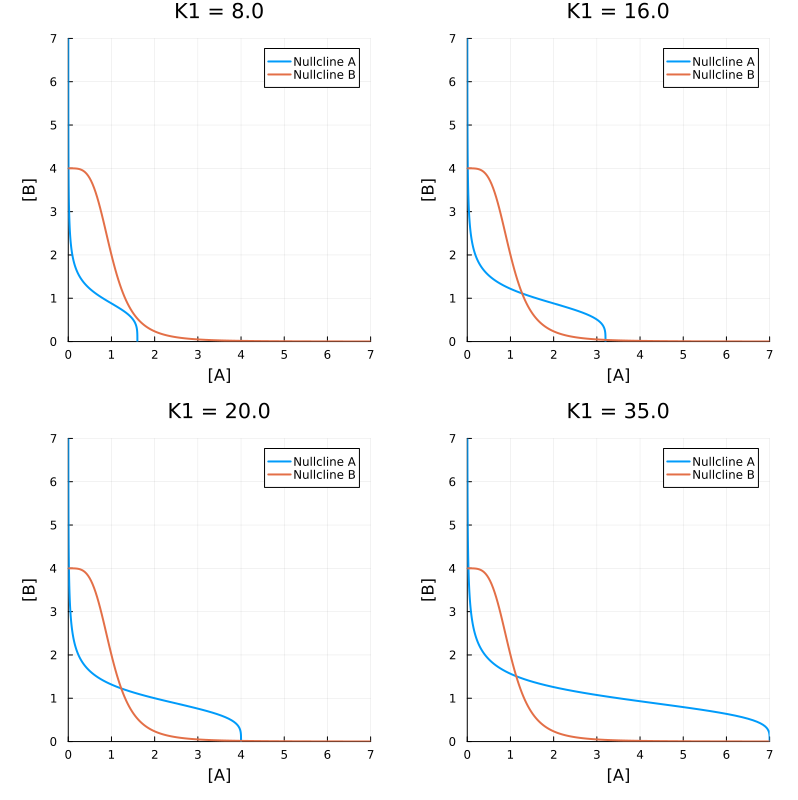
This notebook was generated using Literate.jl.

